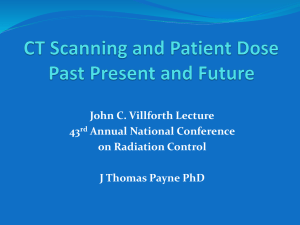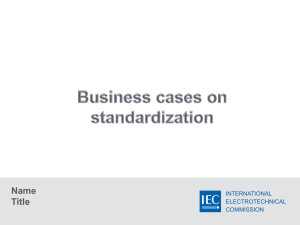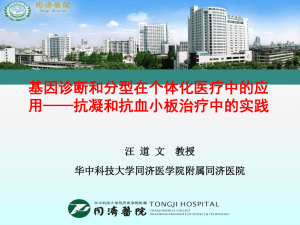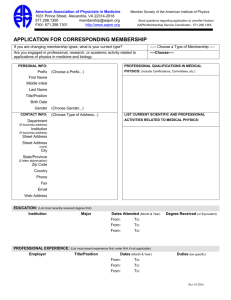PPT
advertisement
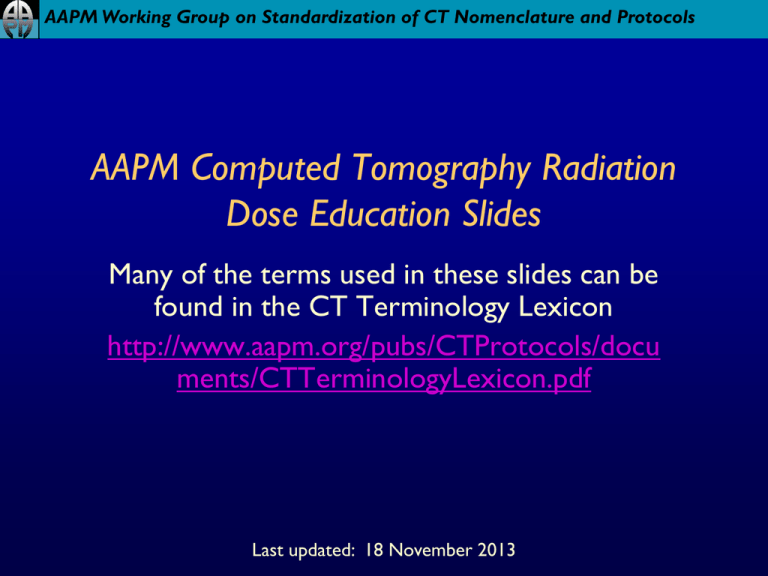
AAPM Working Group on Standardization of CT Nomenclature and Protocols AAPM Computed Tomography Radiation Dose Education Slides Many of the terms used in these slides can be found in the CT Terminology Lexicon http://www.aapm.org/pubs/CTProtocols/docu ments/CTTerminologyLexicon.pdf Last updated: 18 November 2013 AAPM Working Group on Standardization of CT Nomenclature and Protocols Disclaimer • The information contained herein is current as of the date shown on the title slide • The master version of these slides is located at: • http://www.aapm.org/pubs/CTProtocols/documents/ EducationSlides.pptx • Modification of the content of these slides is allowed. – The modified content, including indirect or unintentional changes in the accuracy or meaning of related content, becomes the sole responsibility of the person/organization creating and/or using the edited version. – Neither the AAPM nor the manufacturers participating in creating this slide set assume any responsibility for edited versions of these slides, or for content of oral presentations associated with the original or edited slides. AAPM Working Group on Standardization of CT Nomenclature and Protocols Motivation • These slides are provided to aid in understanding the factors that affect radiation dose in CT studies • Image patients wisely and gently – A CT study should use as little radiation as possible, while still meeting the image quality needs of the exam – A CT study that is non-diagnostic because the radiation dose is too low may require rescanning the patient – increasing the total patient dose imagegently.org imagewisely.org AAPM Working Group on Standardization of CT Nomenclature and Protocols Outline • • • • What is Dose? Acquisition Parameter Settings Dose Modulation and Reduction Dose Display AAPM Working Group on Standardization of CT Nomenclature and Protocols What Is Dose? • Volume Computed Tomography Dose Index (CTDIvol) is a standardized parameter to measure Scanner Radiation Output – CTDIvol is NOT patient dose – CTDIvol is reported in units of mGy for either a 16-cm (for head exams) or 32-cm (for body exams) diameter acrylic phantom – For the same technique settings, the CTDIvol reported for the 16-cm phantom is about twice that of the 32-cm phantom – The reported CTDIvol is based on measurements made by the manufacturer in a factory setting • In these slides, the term "patient dose" is used to describe the absorbed dose to a patient, while the generic term "dose" refers to CTDIvol AAPM Working Group on Standardization of CT Nomenclature and Protocols How is CTDIvol related to patient dose? • CTDIvol is not patient dose • The relationship between the two depends on many factors, including patient size and composition • AAPM Report 204 introduces a parameter known as the Size Specific Dose Estimate (SSDE) to allow estimation of patient dose based on CTDIvol and patient size • For the same CTDIvol, a smaller patient will tend to have a higher patient dose than a larger patient What is Dose? AAPM Working Group on Standardization of CT Nomenclature and Protocols How is CTDIvol related to patient dose? 120 kVp at 200 mAs 120 kVp at 200 mAs 32 cm Phantom CTDIvol = 20 mGy 32 cm Phantom CTDIvol = 20 mGy Both patients scanned with the same CTDIvol Patient dose will be higher for the smaller patient What is Dose? AAPM Working Group on Standardization of CT Nomenclature and Protocols How is CTDIvol related to patient dose? 120 kVp at 100 mAs 120 kVp at 200 mAs 32 cm Phantom CTDIvol = 10 mGy 32 cm Phantom CTDIvol = 20 mGy Smaller patient scanned with a lower CTDIvol Patient doses will be approximately equal What is Dose? AAPM Working Group on Standardization of CT Nomenclature and Protocols Size Specific Dose Estimate (SSDE) • AAPM report 204 describes a method to calculate SSDE using CTDIvol • Conversion factors based on patient size (e.g., AP or lateral width, effective diameter) are provided to estimate patient dose for a patient of that size • However, SSDE is still not the exact patient dose, as factors such as scan length and patient composition may differ from the assumptions used to calculate SSDE • SSDE is not dose to any specific organ, but rather the mean dose in the center of the scanned volume What is Dose? AAPM Working Group on Standardization of CT Nomenclature and Protocols How is CTDIvol related to patient dose? 120 kVp at 100 mAs 120 kVp at 200 mAs 9 cm 27 cm 32 cm Phantom CTDIvol = 10 mGy SSDE = 13.2 mGy 32 cm Phantom CTDIvol = 20 mGy SSDE = 13.2 mGy Patients have equivalent SSDE What is Dose? AAPM Working Group on Standardization of CT Nomenclature and Protocols Why Use CTDIvol? • CTDIvol provides information about the amount of radiation used to perform the study • CTDIvol is a useful index to track across patients and protocols for quality assurance purposes • CTDIvol can be used as a metric to compare protocols across different practices and scanners when related variables, such as resultant image quality, are also taken in account • The ACR Dose Index Registry (DIR) allows comparison across institutions of CTDIvol for similar exam types (e.g., routine head exam) What is Dose? AAPM Working Group on Standardization of CT Nomenclature and Protocols Dose Length Product • The Dose Length Product (DLP) is also calculated by the scanner • DLP is the product of the length of the irradiated scan volume and the average CTDIvol over that distance • DLP has units of mGy*cm What is Dose? AAPM Working Group on Standardization of CT Nomenclature and Protocols Useful Concepts/Terms • The relationships between acquisition parameters and CTDIvol described in the following slides assume all other parameters are held constant • The relationship between a parameter and CTDIvol is often described as proportional in some way – The symbol is used to indicate “proportional to” • Directly proportional means that a change in the parameter results in the same change in CTDIvol – Example: Doubling the rotation time from 0.5 to 1.0 seconds will double the CTDIvol • Inversely proportional means that a change in a parameter has the opposite effect on CTDIvol – Example: Doubling the pitch from 1 to 2 will reduce the CTDIvol by half AAPM Working Group on Standardization of CT Nomenclature and Protocols Acquisition Parameter Settings • Acquisition Parameters define the technique that will be used and how the scan will proceed • Acquisition Parameters are set in the user interface where scans are prescribed • Changing a single Acquisition Parameter while holding everything else constant will typically affect the CTDIvol for that scan • The following slides describe what that affect is for each parameter AAPM Working Group on Standardization of CT Nomenclature and Protocols Scan Mode • CT Scanners offer a variety of Scan Modes which describe how the table moves during an exam • Scan Modes include – Axial – Helical or Spiral – Dynamic The Acquisition Parameters that affect CTDIvol may change amongst different Scan Modes Acquisition Parameter Settings AAPM Working Group on Standardization of CT Nomenclature and Protocols Dynamic Scan Mode Notes • In the Dynamic Scan Mode multiple acquisitions covering the same body region are acquired. Examples of these study types include: – Perfusion Studies – Bolus Tracking Studies – Test Bolus Studies • Dynamic Scans often have large CTDIvol values because the scanner reports the sum of the CTDIvol values from each rotation • The reported CTDIvol is NOT skin dose or organ dose Acquisition Parameter Settings AAPM Working Group on Standardization of CT Nomenclature and Protocols Table Feed/Increment • Is the movement of the table through the bore of the scanner over a full 360 degree rotation • Units: millimeters/rotation or millimeters/second • The parameter is known both as Table Feed (helical/spiral acquisition) & Table Increment (axial acquisition) Table Feed affects CTDIvol through its inclusion in Pitch (discussed later) Acquisition Parameter Settings AAPM Working Group on Standardization of CT Nomenclature and Protocols Detector Configuration • Is the combination of the number of data channels and the width of the detector associated with each data channel • The Detector Configuration determines the Beam Width or Beam Collimation (nT), which is the number of channels (n) times the detector width associated with each data channel (T) • For a selected detector width per data channel, a smaller total Beam Collimation usually has a higher CTDIvol than a larger Beam Collimation – Example: On a 16 slice scanner with a detector width per channel of 1.25 mm, a collimation of 4x1.25mm is generally less dose efficient than a collimation of 16x1.25mm Users should monitor CTDIvol values when changing detector configuration Acquisition Parameter Settings AAPM Working Group on Standardization of CT Nomenclature and Protocols Detector Configuration Acquisition Parameter Settings AAPM Working Group on Standardization of CT Nomenclature and Protocols Pitch • Is the Table Feed per gantry rotation divided by the beam width/collimation • Pitch is the ratio of two distances and therefore has no units • Users should monitor other parameters when changing Pitch. The scanner may or may not automatically compensate for changes in Pitch (for example, by changing the tube current) to maintain the planned CTDIvol. CTDIvol 1/Pitch: Hitachi, Toshiba (no AEC) CTDIvol independent of Pitch: GE, Siemens, Philips, Neusoft, Toshiba (AEC) Acquisition Parameter Settings AAPM Working Group on Standardization of CT Nomenclature and Protocols Pitch • CTDIvol may not change in the expected manner if the scanner automatically adjust other parameters when the pitch is changed • The relationships between CTDIvol and pitch for the different vendors are described below – CTDIvol inversely proportional to change in pitch: Hitachi, NeuroLogica – CTDIvol constant when pitch is changed due to changes to other parameters: GE, Neusoft, Philips and Siemens – The relationship between CTDIvol and pitch depends on scan mode or Software version: Toshiba AAPM Working Group on Standardization of CT Nomenclature and Protocols Pitch Pitch < 1 Beam Width has some overlap at each view angle from rotation to rotation Pitch = 1 No overlap of Beam Width at each view angle and no view angles not covered at certain table positions Pitch > 1 Some view angles are not covered by the beam width at certain table positions Acquisition Parameter Settings AAPM Working Group on Standardization of CT Nomenclature and Protocols Exposure Time per Rotation • Is the length of time, in seconds, that the X-ray beam is “on” during a gantry rotation – It takes into account the gantry rotation time and angular acquisition range • Units: seconds • Users should monitor other parameters when changing Exposure Time per Rotation. The scanner may or may not automatically compensate for changes in Exposure Time per Rotation(for example, by changing the tube current) CTDIvol Exposure Time per Rotation Hitachi, NeuroLogica, Toshiba (no AEC) CTDIvol independent of Exposure Time per Rotation: GE, Siemens, Philips, Neusoft, Toshiba (AEC) Acquisition Parameter Settings AAPM Working Group on Standardization of CT Nomenclature and Protocols Exposure Time per Rotation • CTDIvol may not change in the expected manner if the scanner automatically adjust other parameters when the exposure time per rotation is changed • The relationships between CTDIvol and exposure time per rotation for the different vendors are described below – CTDIvol proportional to change in parameter: Hitachi and NeuroLogica – CTDIvol constant when the parameter is changed due to changes to other parameters: GE, Neusoft, Philips and Siemens – The relationship between CTDIvol and the parameter depends on scan mode or Software version: Toshiba AAPM Working Group on Standardization of CT Nomenclature and Protocols Tube Current • Determines the number of electrons accelerated across the x-ray tube per unit time • Units: milliAmperes (mA) • CTDIvol is directly proportional to Tube Current CTDIvol Tube Current Acquisition Parameter Settings AAPM Working Group on Standardization of CT Nomenclature and Protocols Tube Potential • Is the electrical potential applied across the x-ray tube to accelerate electrons toward the target material • Units: kiloVolts (kV or kVp) • CTDIvol is approximately proportional to the square of the percentage change in Tube Potential CTDI vol kV new kV old Acquisition Parameter Settings n n ≈ 2 to 3 AAPM Working Group on Standardization of CT Nomenclature and Protocols Tube Current Time Product • Is the product of Tube Current and the Exposure Time per Rotation • Units: milliAmpere-seconds (mAs) • CTDIvol is directly proportional to Tube Current Time Product CTDIvol Tube Current Time Product Acquisition Parameter Settings AAPM Working Group on Standardization of CT Nomenclature and Protocols Effective Tube Current Time Product • Is the product of the Tube Current and the Exposure Time per Rotation divided by the Pitch • Units: milliAmpere-Seconds (mAs) • CTDIvol is directly proportional to Effective Tube Current Time Product CTDIvol Effective Tube Current Time Product Acquisition Parameter Settings AAPM Working Group on Standardization of CT Nomenclature and Protocols Field Of Measurement • Is the diameter of the primary beam in the axial plane at the gantry iso-center • Units: millimeters (mm) • CTDIvol may decrease with a decrease in the Field of Measurement – The relationship is vendor specific Users should monitor the CTDIvol values when changing the Field of Measurement Acquisition Parameter Settings AAPM Working Group on Standardization of CT Nomenclature and Protocols Beam Shaping Filter • Is the scanner component that modifies the energy spectrum and spatial distribution of the primary beam • Beam Shaping may include a bow tie filter and/or flat filters • CTDIvol is affected by a change in Beam Shaping Filters – The relationship is vendor and filter specific Users should monitor CTDIvol values when changing the Beam Shaping Filter Acquisition Parameter Settings AAPM Working Group on Standardization of CT Nomenclature and Protocols Acquisition Parameter Settings Summary Parameter Relationship to CTDIvol Scan Mode Changes in the Scan Mode may affect CTDIvol Table Feed/Increment Table Feed affects CTDIvol through its inclusion in Pitch Detector Configuration Decreasing the Beam Collimation typically, but not always, increases the CTDIvol Pitch CTDIvol relationship to pitch is vendor dependent Exposure Time Per Rotation CTDIvol relationship to exposure time per rotation is vendor dependent Tube Current CTDIvol Tube Current Tube Potential CTDIvol (kVp1/kVp2)n Tube Current Time Product CTDIvol Tube Current Time Product n ~ 2 to 3 Effective Tube CTDIvol Effective Tube Current Time Product Current Time Product Field of Measurement Changes in the Field of Measurement may affect CTDIvol Beam Shaping Filter Changes in the Beam Shaping Filter may affect CTDIvol AAPM Working Group on Standardization of CT Nomenclature and Protocols Dose Modulation and Reduction • Many CT scanners automatically adjust the technique parameters (and as a result the CTDIvol) to achieve a desired level of image quality and/or to reduce dose • Dose Modulation and Reduction techniques vary by scanner manufacturer, model and software version AAPM Working Group on Standardization of CT Nomenclature and Protocols Automatic Exposure Control (AEC) • Automatically adapts the Tube Current or Tube Potential according to patient attenuation to achieve a specified image quality – Automatic adjustment of Tube Current may not occur when Tube Potential is changed – Centering the patient in the gantry is VITAL for most AEC systems • AEC aims to deliver a specified image quality across a range of patient sizes. It tends to increase CTDIvol for large patients and decrease it for small patients relative to a reference patient size The use of Automatic Exposure Control may decrease or increase CTDIvol depending on the patient size and body area imaged and image quality requested Dose Modulation and Reduction AAPM Working Group on Standardization of CT Nomenclature and Protocols Image Quality Reference Parameter • Is the AEC parameter that is set by the user to define the desired level of image quality • Changing the Image Quality Reference Parameter will affect the CTDIvol The effect on CTDIvol when changing the Image Quality Reference Parameter is vendor dependent Dose Modulation and Reduction AAPM Working Group on Standardization of CT Nomenclature and Protocols Image Quality Reference Parameter • A change in the Image Quality Reference Parameter will affect the CTDIvol • Setting the parameter for “increased” image quality (e.g., lower noise) will result in more dose • Setting the parameter for “decreased” image quality (e.g., more noise) will result in less dose Dose Modulation and Reduction AAPM Working Group on Standardization of CT Nomenclature and Protocols Angular Tube Current Modulation • Is an AEC feature that adjusts the Tube Current as the x-ray tube rotates around the patient to compensate for attenuation changes with view angle • Angular Tube Current Modulation is used to adjust the Tube Current to attempt to deliver similar dose to the detector at all view angles The use of Angular Tube Current Modulation may decrease or increase CTDIvol depending on the patient size and body area imaged and image quality requested Dose Modulation and Reduction AAPM Working Group on Standardization of CT Nomenclature and Protocols Angular Tube Current Modulation • Angular Tube Current Modulation uses information from one or two view localizers Dose Modulation and Reduction AAPM Working Group on Standardization of CT Nomenclature and Protocols Longitudinal Tube Current Modulation • Is an AEC feature that adjusts the Tube Current as patient attenuation changes in the longitudinal direction • The CT Localizer Radiograph is used to estimate patient attenuation The use of Longitudinal Tube Current Modulation may decrease or increase CTDIvol depending on the patient size and body area imaged and image quality requested Dose Modulation and Reduction AAPM Working Group on Standardization of CT Nomenclature and Protocols Longitudinal Tube Current Modulation • Longitudinal Tube Current Modulation uses information from one or two view localizers Dose Modulation and Reduction AAPM Working Group on Standardization of CT Nomenclature and Protocols Angular and Longitudinal Tube Current Modulation • Is an AEC feature that incorporates the properties of both Angular and Longitudinal Tube Current Modulation to – Adjust the Tube Current based on the patient’s overall attenuation – Modulate the Tube Current in the angular (X-Y) and longitudinal (Z) dimensions to adapt to the patient’s shape The use of Angular and Longitudinal Tube Current Modulation may decrease or increase CTDIvol depending on the patient size and body area imaged and image quality requested Dose Modulation and Reduction AAPM Working Group on Standardization of CT Nomenclature and Protocols Angular and Longitudinal Tube Current Modulation Dose Modulation and Reduction AAPM Working Group on Standardization of CT Nomenclature and Protocols ECG-Based Tube Current Modulation • Is an AEC feature used with prospectively gated cardiac imaging that adjusts the Tube Current based on the phase within the cardiac cycle • There are important heart rate considerations to take into account when using prospective gating The use of ECG-Based Tube Current Modulation with prospective gating will decrease CTDIvol compared to retrospective gating Dose Modulation and Reduction AAPM Working Group on Standardization of CT Nomenclature and Protocols ECG-Based Tube Current Modulation Multiple heart beats and table positions may be required to collect all of the data required to reconstruct the FOV including the heart Radiation On Dose Modulation and Reduction AAPM Working Group on Standardization of CT Nomenclature and Protocols Organ-Based Tube Current Modulation • Is an AEC feature that allows for the tube current to be decreased or turned off over radiosensitive organs on the patient periphery, such as the breasts or eye lenses • To maintain image quality, tube current may need to be increased at other view angles The use of Organ-Based Tube Current Modulation may reduce the absorbed dose to organs at the surface of the body but may increase the absorbed dose to other organs Dose Modulation and Reduction AAPM Working Group on Standardization of CT Nomenclature and Protocols Organ-Based Tube Current Modulation Gantry Gantry Conventional Organ-Based Modulation Dose Modulation and Reduction AAPM Working Group on Standardization of CT Nomenclature and Protocols Automatic Tube Potential Selection • Is an AEC feature that selects the tube potential according to the diagnostic task and patient size in order to achieve the desired image quality at a lower CTDIvol The use of Automatic Tube Potential Selection is intended to decrease CTDIvol while achieving the image quality required for a specific diagnostic task and patient attenuation Dose Modulation and Reduction AAPM Working Group on Standardization of CT Nomenclature and Protocols Automatic Tube Potential Selection • Tube Potential is not modulated in the same fashion as Tube Current • It does not change with different tube positions (view angles) around the patient • The Tube Potential for a specific patient, anatomic region and diagnostic tasks is selected and held constant for that acquisition, though it may be changed to a different tube potential for a different diagnostic task Dose Modulation and Reduction AAPM Working Group on Standardization of CT Nomenclature and Protocols Iterative Reconstruction • Is a feature that uses the information acquired during the scan and repeated reconstruction steps to produce an image with less “noise” or better image quality (e.g., higher spatial resolution or decreased artifacts) than is achievable using standard reconstruction techniques The use of Iterative Reconstruction by itself may not decrease CTDIvol; with use of Iterative Reconstruction, image quality will change and this may allow a reduction in the CTDIvol by adjusting the acquisition parameters used for the exam Dose Modulation and Reduction AAPM Working Group on Standardization of CT Nomenclature and Protocols Iterative Reconstruction • Iterative Reconstruction may be completed using data in Image Space, Sinogram Space or a Model Based Approach • Changing/Turning On the %/Level of the iterative reconstruction used may or may not affect the CTDIvol of the scan and will affect the image quality of the final set of images • In consultation, the Radiologists and Medical Physicists at an institution may adjust the acquisition parameters for studies reconstructed using iterative reconstruction based on the imaging task, the patient population, the desired image quality, dose concerns and the needs of the interpreting Radiologist Dose Modulation and Reduction AAPM Working Group on Standardization of CT Nomenclature and Protocols Noise Reduction Using Other Post Processing Software • Other commercially available products can be used to reduce image noise in already reconstructed images • In consultation, the radiologists and medical physicists may adjust the acquisition parameters to reduce the CTDIvol used for studies that will be processed using these products, taking into consideration the imaging task and patient population, dose concerns, and the needs of the interpreting radiologist(s) Dose Modulation and Reduction AAPM Working Group on Standardization of CT Nomenclature and Protocols Dose Display • Information about the CTDIvol planned for each scan is typically displayed before the exam on the user console • Information about the CTDIvol delivered by each scan is typically reported in a data page or DICOM structured dose report • Dose information provided after the exam typically also includes the DLP and the CTDI phantom size. These may also be included in information displayed before the scan. AAPM Working Group on Standardization of CT Nomenclature and Protocols Display of Planned CTDIvol • CTDIvol is displayed before a study is performed based on the selected technique parameters • It is important to check CTDIvol before a study is performed to ensure that the output of the scanner is appropriate for the specific patient and diagnostic task CTDIvol is displayed for each planned acquisition Dose Display AAPM Working Group on Standardization of CT Nomenclature and Protocols Post Study Data Page • Following the completion of a study, a Post Study Data Page is created that includes information on the delivered CTDIvol and DLP and the phantom size used to calculate these values • Information is displayed for each series Dose Display AAPM Working Group on Standardization of CT Nomenclature and Protocols Post Study Data Page - CTDIvol • CTDIvol is displayed for each series after a study is performed and is calculated based on the technique factors used to acquire the data • It is useful to check CTDIvol after a study is performed to ensure that the output of the scanner was as expected CTDIvol is displayed for each completed acquisition Dose Display AAPM Working Group on Standardization of CT Nomenclature and Protocols Post Study Data Page - DLP • DLP is displayed for each series after a study is performed and is calculated based on the technique factors and scan length used DLP is displayed for each completed acquisition and is typically summed for all of the acquisitions Dose Display AAPM Working Group on Standardization of CT Nomenclature and Protocols Post Study Data Page – CTDI Phantom • The CTDI Phantom used for each acquisition in the study is typically displayed • Different phantoms may be used to calculate the CTDIvol for different acquisitions in the same study (and may vary by vendor) – Head and C-Spine Example • Body Phantom used to report CTDIvol for C-Spine portion of exam • Head Phantom used to report CTDIvol for Head portion of exam Dose Display AAPM Working Group on Standardization of CT Nomenclature and Protocols Summing Dose Report Values • CTDIvol values for separate series are NOT to be summed to give a “total” CTDIvol for a study – This is especially true if the series cover different anatomic regions • DLP is typically summed over all series in the Post Study Data Page to provide an estimate of the total patient exposure – Extreme care should be taken when considering summed DLPs because different phantoms may have been used to calculate the CTDIvol values used to determine DLP • A medical physicist should be contacted if patient specific dose estimates are required Dose Display AAPM Working Group on Standardization of CT Nomenclature and Protocols Dose Notification Levels • Notification Levels may be set on a CT scanner for each series within an exam protocol • If the planned CTDIvol is above the Notification Level and triggers the notification, the user has the opportunity to edit or confirm the technique settings • Notification Levels may be exceeded when appropriate for a specific patient or diagnostic task (e.g., in very large patients or contrast bolus monitoring scans) Dose Display AAPM Working Group on Standardization of CT Nomenclature and Protocols Dose Alert Levels • Dose Alert Levels require specific action by the operator to continue scanning • Dose Alert Levels are typically much higher than Notification Levels and take into account all series within the exam • Triggering a Dose Alert requires that the operator confirm the protocol and settings are correct by entering in his or her name. Optionally, sites may require that the operator provide a brief explanation in the provided field Dose Display AAPM Working Group on Standardization of CT Nomenclature and Protocols Radiation Dose Structured Reports • Radiation Dose Structured Reports (RDSRs) are provided in newer software versions in a defined DICOM format • They provide the most complete set of information regarding the irradiating events • The reports are very detailed and require an RDSR viewer for easy visualization of relevant information Dose Display AAPM Working Group on Standardization of CT Nomenclature and Protocols Questions • Please contact the medical physicist providing support for your CT practice, your lead technologist, supervising radiologist or manufacturer’s application specialist with questions regarding these important topics and concepts. AAPM Working Group on Standardization of CT Nomenclature and Protocols Acknowledgements • AAPM – Dianna Cody, Dustin Gress, Michael Heard, Jim Kofler, Cynthia McCollough, Mike McNitt-Gray, Bob Pizzutiello, Mark Supanich • ACR – Mark Armstrong, Penny Butler, Dina Hernandez • ASRT – Virginia Lester • DICOM – David Clunie, Kevin O’Donnell • FDA – Thalia Mills AAPM Working Group on Standardization of CT Nomenclature and Protocols Acknowledgements • GE – John Jaeckle • Hitachi – Mark Silverman • Philips – Amar Dhanantwari • Neusoft – Keith Mildenberger • Neurologica – Donald Fickett • Siemens – Christianne Liedecker • Toshiba – Kristen Boedecker • MITA – Brian Abraham

